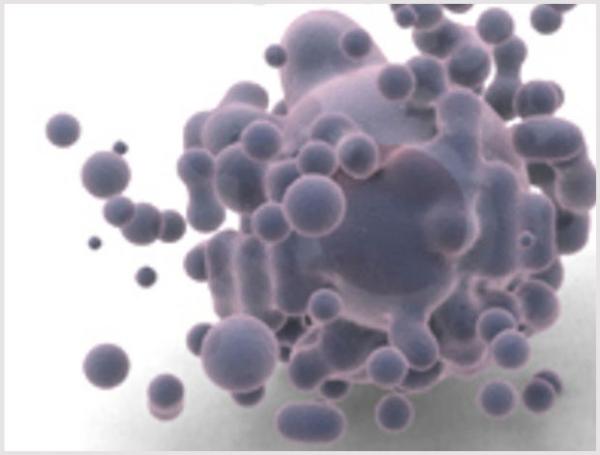Cellular Self-Destruct Tied to Type 2 Diabetes
Study Suggests New Treatment Strategy for Increasingly Common Disease

New IRP research points toward a new treatment strategy for type 2 diabetes that works by inhibiting a cellular ‘self-destruct’ process called apoptosis in cells that help control blood sugar.
In the classic sci-fi film Alien, the protagonist attempts to destroy the titular monster by triggering the self-destruct mechanism on her spaceship. Our cells also sometimes need to destroy themselves in order to circumvent threats like cancer, but uncontrolled cell death can lead to disease. New IRP research suggests that preventing certain cells in the pancreas from tripping their self-destruct switch could help relieve the symptoms of type 2 diabetes.1
When levels of sugar, or glucose, in the blood are high, cells in the pancreas called beta cells produce a hormone called insulin that allows the body’s cells to burn glucose for fuel. In individuals with diabetes, cells have difficulty taking in glucose due to a combination of low insulin levels and a reduced response to insulin. The resulting chronically high blood sugar can damage the body.
While type 1 diabetes occurs when the body’s immune system attacks beta cells, the mechanisms driving type 2 diabetes are more mysterious. IRP senior investigator Sushil Rane, Ph.D., the new study’s senior author, believes an important clue lies in a 2003 study that observed many more beta cells dying due to a cellular ‘self-destruct’ process called apoptosis in individuals with type 2 diabetes compared to people without the illness.2 This led to a noticeable reduction in the number of beta cells in the diabetic patients’ bodies.
“Right now, we still do not have front-line therapeutics to stop the progression to diabetes, and I’m hoping that looking into how we can prevent untimely beta cell death could be one of the ways to slow down or stop the disease,” says Dr. Rane.
Inspired by that study, Dr. Rane’s team — led by IRP biologist Ji-Hyeon Lee, Ph.D., the new study’s first author — began its own experiments by feeding mice a high-fat diet in order to induce diabetes-like blood sugar problems. The scientists also examined groups of cells extracted from the animals’ pancreases called pancreatic islets, which contain beta cells. The islets from the diabetic mice released less insulin in response to glucose and showed more signs of apoptosis than islets from mice fed a normal diet.

Dr. Sushil Rane
What’s more, the blood of mice fed a high-fat diet contained more of an apoptosis-promoting molecule called TGF-beta. When TGF-beta binds to a cell’s TGF-beta receptors, it activates a protein called Smad3, which in turn triggers a sequence of events that leads to apoptosis in that cell. Islets from mice fed a high-fat diet had higher levels of activated Smad3 than islets from mice on a normal diet, suggesting there was increased beta cell apoptosis in the mice with diabetes-like blood sugar problems.
In subsequent experiments, Dr. Rane’s team studied transgenic mice whose beta cells contained either over-active Smad3 or non-functional Smad3. When fed a high-fat diet, the mice with over-active Smad3 developed diabetes-like blood sugar problems, whereas the mice with defunct Smad3 did not. Moreover, a high-fat diet triggered much more beta cell apoptosis in mice with hyperactive Smad3 compared to normal mice, but mice with non-functioning Smad3 had lower levels of beta cell apoptosis and more beta cells in their pancreases than normal mice.
The IRP scientists then moved on to scrutinizing preserved pancreatic islets from the bodies of deceased type 2 diabetics and non-diabetic individuals. The islets from the diabetics had much higher levels of activated Smad3 and their beta cells died in greater numbers when exposed to a fat molecule known to trigger apoptosis. However, apoptosis triggered by that molecule or by TGF-beta was reduced when Dr. Rane’s team blocked the TGF-beta receptor or inhibited a molecule called FOXO1, which activates apoptosis-related genes when it interacts with activated Smad3. Moreover, islets from mice completely lacking Smad3 also experienced less beta cell death when exposed to the apoptosis-inducing fat molecule.
“There were three places where we could interfere with beta cell apoptosis: TGF-beta, Smad3, and FOXO1,” explains Dr. Rane. “These findings could have important downstream applications because, if you want to slow down the process, you have multiple opportunities to do so.”
If future studies confirm the IRP researchers’ discoveries, scientists like Dr. Rane can begin testing potential treatments for type 2 diabetes that block one of the many steps involved in beta cell apoptosis. Dr. Rane also plans to search for a molecule in blood that could be measured to track the amount of beta cell death occurring in patients with type 2 diabetes.
“Our study will hopefully spur scientists to look at the problem of beta cell failure from a different viewpoint,” says Dr. Rane. “Predicting the development of beta cell failure in type 2 diabetes, more efficiently diagnosing it, and curing it may be possible if scientists look at apoptosis as one of the principal mechanisms driving the disease.”
Subscribe to our weekly newsletter to stay up-to-date on the latest breakthroughs in the NIH Intramural Research Program.
References:
[1] Protection from β-cell apoptosis by inhibition of TGF-β/Smad3 signaling. Lee JH, Mellado-Gil JM, Bahn YJ, Pathy SM, Zhang YE, Rane SG. Cell Death Dis. 2020 Mar 13;11(3):184. doi: 10.1038/s41419-020-2365-8.
[2] Beta-cell deficit and increased beta-cell apoptosis in humans with type 2 diabetes. Butler AE, Janson J, Bonner-Weir S, Ritzel R, Rizza RA, Butler PC. Diabetes. 2003 Jan;52(1):102-10.
Related Blog Posts
This page was last updated on Tuesday, May 23, 2023
